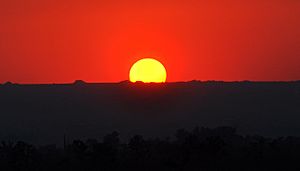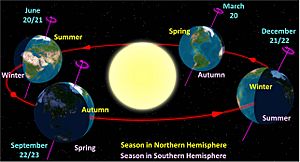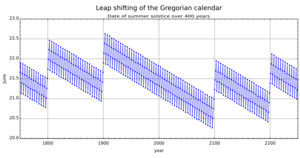Summer solstice facts for kids
The summer solstice is a special day when one of Earth's ends (its pole) leans the most towards the Sun. This happens twice a year, once for the top half of Earth (the Northern Hemisphere) and once for the bottom half (the Southern Hemisphere).
For whichever half of Earth is leaning towards the Sun, the summer solstice is the day when the Sun reaches its highest point in the sky. It's also the day with the longest period of daylight all year! If you live near the North Pole (in the Northern Hemisphere) or the South Pole (in the Southern Hemisphere), you might even see sunlight all day and all night around the summer solstice. This is called the Midnight Sun.
The summer solstice happens during the summer season. In the Northern Hemisphere, it's called the June solstice and usually falls between June 20 and June 22. In the Southern Hemisphere, it's called the December solstice and happens between December 20 and December 23. The same dates in the opposite hemisphere are known as the winter solstice, which is the shortest day of the year.
For a very long time, even before history was written down, people have seen the summer solstice as an important time. Many cultures have celebrated it with special parties and traditions. In many places, especially in Europe, the summer solstice is traditionally seen as the middle of summer. But today, in some countries, it's considered the start of summer.
Contents
What Makes the Summer Solstice Special?
The summer solstice is the longest day of the year for a hemisphere. However, the exact dates for the earliest sunrise and latest sunset can be a little different. This is because Earth travels around the Sun in a slightly oval shape, not a perfect circle. This means its speed changes a tiny bit throughout the year.
For most places, the Sun appears highest in the sky on the summer solstice. But if you live in certain tropical areas (between the Tropic of Cancer and Tropic of Capricorn), the Sun might be directly overhead (straight up at 90 degrees) on a different day. This can happen twice a year in those places.
No matter where you are, the Sun's position at noon is as far north as it gets on the June solstice. It's as far south as it gets on the December solstice.
Full Moon and Solstice
In 2016, something special happened: a full moon and the Northern Hemisphere's summer solstice were on the same day for the first time in almost 70 years! The full moon rose just as the Sun was setting.
Cultural Celebrations

People around the world have celebrated the summer solstice in many different ways. Most cultures recognize this event with holidays, festivals, and special traditions. These celebrations often involve themes of religion or new life.
The word solstice comes from two Latin words: sol, meaning Sun, and sistere, meaning to stand still. This describes how the Sun seems to "stand still" in the sky around this time.
When Does It Happen?
Summer Solstice Celebrations Around the World
Many cultures celebrate the summer solstice! Here are some examples:
- Midsummer (celebrated in many parts of Europe)
- Dragon Boat Festival (in East Asia)
- Christmas (often marks the southern summer solstice)
- Day of Private Reflection (in Northern Ireland)
- Juhannus (in Finland)
- Jāņi (in Latvia)
- National Aboriginal Day (in Canada)
- Tiregān (in Iran)
- Fremont Solstice Parade (in Fremont, Seattle, Washington, United States)
- Santa Barbara Summer Solstice Parade (in Santa Barbara, California, United States)
- International Surfing Day
- International Yoga Day
- Fête de la Musique, also known as World Music Day
Winter Solstice Celebrations in the Southern Hemisphere
While it's summer in the Northern Hemisphere, it's winter in the Southern Hemisphere. Some cultures there celebrate their winter solstice:
- Inti Raymi, in Machu Picchu, Peru
- We Tripantu, celebrated by the Mapuche people in southern Chile
- Willkakuti, an Andean-Amazonic New Year celebrated by the Aymara
Daylight Hours During the Summer Solstice
The following tables contain information on the length of the day on the 20th June, close to the summer solstice of the Northern Hemisphere and winter solstice of the Southern Hemisphere (i.e. June solstice). The data was collected from the website of the Finnish Meteorological Institute on 20 June 2016 as well as from certain other websites.
The data is arranged geographically and within the tables from the longest day to the shortest one.
| Fennoscandia and the Baltic states | |||
| City | Sunrise 20 June 2016 |
Sunset 20 June 2016 |
Length of the day |
|---|---|---|---|
| Murmansk | — | — | 24 h |
| Bodø | — | — | 24 h |
| Rovaniemi | — | — | 24 h |
| Luleå | 1:00 | 21.6.2016 0:05 | 23 h 04 min |
| Kem’ | 1:44 | 23:42 | 21 h 58 min |
| Reykjavík | 2:55 | 21.6.2016 0:03 | 21 h 08 min |
| Trondheim | 3:02 | 23:37 | 20 h 35 min |
| Tórshavn | 3:36 | 23:21 | 19 h 45 min |
| Petrozavodsk | 2:55 | 22:33 | 19 h 38 min |
| Helsinki | 3:54 | 22:49 | 18 h 55 min |
| Saint Petersburg | 3:35 | 22:25 | 18 h 50 min |
| Oslo | 3:53 | 22:43 | 18 h 49 min |
| Tallinn | 4:03 | 22:42 | 18 h 39 min |
| Stockholm | 3:30 | 22:07 | 18 h 37 min |
| Riga | 4:29 | 22:21 | 17 h 52 min |
| Copenhagen | 4:25 | 21:57 | 17 h 32 min |
| Vilnius | 4:41 | 21:59 | 17 h 17 min |
| Europe | |||
| City | Sunrise 20 June 2016 |
Sunset 20 June 2016 |
Length of the day |
|---|---|---|---|
| Edinburgh | 4:26 | 22:02 | 17 h 36 min |
| Moscow | 3:44 | 21:17 | 17 h 33 min |
| Berlin | 4:43 | 21:33 | 16 h 49 min |
| London | 4:43 | 21:21 | 16 h 38 min |
| Paris | 5:46 | 21:57 | 16 h 10 min |
| Rome | 5:34 | 20:48 | 15 h 13 min |
| Madrid | 6:44 | 21:48 | 15 h 03 min |
| Lisbon | 6:11 | 21:04 | 14 h 52 min |
| Athens | 6:02 | 20:50 | 14 h 48 min |
| Africa | |||
| City | Sunrise 20 June 2016 |
Sunset 20 June 2016 |
Length of the day |
|---|---|---|---|
| Cairo | 4:54 | 18:59 | 14 h 04 min |
| Dakar | 6:41 | 19:41 | 12 h 59 min |
| Addis Ababa | 6:07 | 18:46 | 12 h 38 min |
| Nairobi | 6:32 | 18:35 | 12 h 02 min |
| Kinshasa | 6:04 | 17:56 | 11 h 52 min |
| Dar es Salaam | 6:32 | 18:16 | 11 h 43 min |
| Luanda | 6:20 | 17:56 | 11 h 36 min |
| Jamestown | 6:49 | 17:59 | 11 h 10 min |
| Antananarivo | 6:21 | 17:21 | 10 h 59 min |
| Windhoek | 6:30 | 17:15 | 10 h 44 min |
| Johannesburg | 6:54 | 17:24 | 10 h 29 min |
| Cape Town | 7:51 | 17:44 | 9 h 53 min |
| Middle East | |||
| City | Sunrise 20 June 2016 |
Sunset 20 June 2016 |
Length of the day |
|---|---|---|---|
| Tehran | 5:48 | 20:23 | 14 h 34 min |
| Beirut | 5:27 | 19:52 | 14 h 24 min |
| Baghdad | 4:53 | 19:14 | 14 h 21 min |
| Jerusalem | 5:33 | 19:47 | 14 h 13 min |
| Riyadh | 5:04 | 18:44 | 13 h 39 min |
| Muscat | 5:19 | 18:55 | 13 h 35 min |
| Sana'a | 5:33 | 18:35 | 13 h 02 min |
| Americas | |||
| City | Sunrise 20 June 2016 |
Sunset 20 June 2016 |
Length of the day |
|---|---|---|---|
| Fairbanks | 2:57 | 21.6. 00:47 | 21 h 49 min |
| Nuuk | 2:53 | 21.6. 00:03 | 21 h 09 min |
| Iqaluit | 2:11 | 23:00 | 20 h 49 min |
| Anchorage | 4:20 | 23:41 | 19 h 21 min |
| Kodiak | 5:07 | 23:14 | 18 h 06 min |
| Sitka | 4:06 | 22:00 | 17 h 54 min |
| Unalaska | 6:34 | 23:41 | 17 h 06 min |
| Edmonton | 5:04 | 22:07 | 17 h 02 min |
| Vancouver | 5:06 | 21:21 | 16 h 14 min |
| Seattle | 5:11 | 21:10 | 15 h 59 min |
| Ottawa | 5:14 | 20:54 | 15 h 40 min |
| Toronto | 5:35 | 21:02 | 15 h 26 min |
| New York | 5:24 | 20:30 | 15 h 05 min |
| Washington, D.C. | 5:42 | 20:36 | 14 h 53 min |
| Los Angeles | 5:42 | 20:07 | 14 h 25 min |
| Miami | 6:30 | 20:14 | 13 h 44 min |
| Havana | 6:44 | 20:17 | 13 h 33 min |
| Honolulu | 5:50 | 19:16 | 13 h 25 min |
| Mexico City | 6:59 | 20:17 | 13 h 18 min |
| Managua | 5:21 | 18:11 | 12 h 50 min |
| Bogotá | 5:46 | 18:09 | 12 h 23 min |
| Quito | 6:12 | 18:19 | 12 h 06 min |
| Lima | 6:27 | 17:52 | 11 h 24 min |
| La Paz | 6:59 | 18:08 | 11 h 08 min |
| Rio de Janeiro | 6:32 | 17:16 | 10 h 43 min |
| São Paulo | 6:47 | 17:28 | 10 h 40 min |
| Porto Alegre | 7:20 | 17:32 | 10 h 12 min |
| Santiago | 7:46 | 17:42 | 9 h 56 min |
| Buenos Aires | 8:00 | 17:50 | 9 h 49 min |
| Ushuaia | 9:58 | 17:11 | 7 h 12 min |
| Asia and Oceania | |||
| City | Sunrise 20 June 2016 |
Sunset 20 June 2016 |
Length of the day |
|---|---|---|---|
| Provideniya | 0:52 | 22:16 | 21 h 23 min |
| Magadan | 3:37 | 22:19 | 18 h 41 min |
| Petropavlovsk | 4:58 | 21:55 | 16 h 56 min |
| Khabarovsk | 4:57 | 21:04 | 16 h 07 min |
| Ulaanbaatar | 5:52 | 21:54 | 16 h 01 min |
| Vladivostok | 5:32 | 20:55 | 15 h 22 min |
| Beijing | 4:45 | 19:46 | 15 h 00 min |
| Seoul | 5:11 | 19:56 | 14 h 46 min |
| Tokyo | 4:25 | 19:00 | 14 h 34 min |
| Shanghai | 4:50 | 19:01 | 14 h 10 min |
| Lhasa | 6:55 | 20:58 | 14 h 03 min |
| Delhi | 5:23 | 19:21 | 13 h 58 min |
| Kathmandu | 5:08 | 19:02 | 13 h 53 min |
| Taipei | 5:04 | 18:46 | 13 h 41 min |
| Hong Kong | 5:39 | 19:09 | 13 h 30 min |
| Manila | 5:27 | 18:27 | 12 h 59 min |
| Bangkok | 5:51 | 18:47 | 12 h 56 min |
| Singapore | 7:00 | 19:12 | 12 h 11 min |
| Jakarta | 6:01 | 17:47 | 11 h 45 min |
| Darwin | 7:06 | 18:29 | 11 h 23 min |
| Papeete | 6:27 | 17:32 | 11 h 04 min |
| Sydney | 6:59 | 16:53 | 9 h 53 min |
| Auckland | 7:33 | 17:11 | 9 h 37 min |
| Melbourne | 7:35 | 17:07 | 9 h 32 min |
| Dunedin | 8:19 | 16:59 | 8 h 39 min |
During the June solstice (when it's summer in the Northern Hemisphere), the amount of daylight increases as you go from the equator towards the North Pole. This means places closer to the North Pole have much longer days. At the same time, in the Southern Hemisphere, the amount of daylight decreases as you go towards the South Pole, because it's their winter solstice.
See also
 In Spanish: Solsticio de verano para niños
In Spanish: Solsticio de verano para niños



